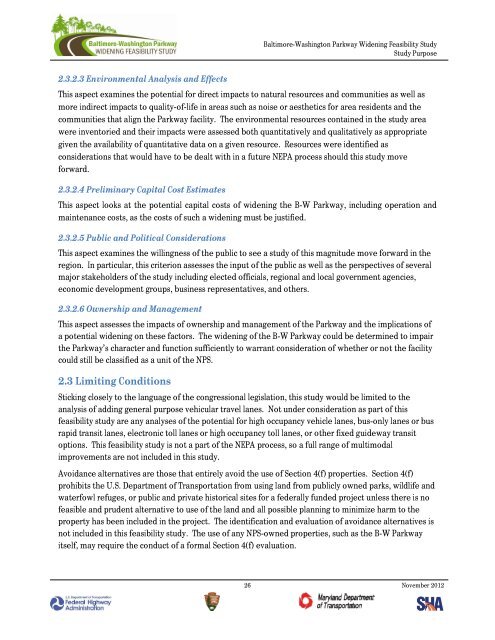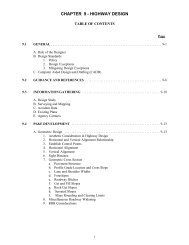Baltimore-Washington Parkway Widening Feasibility Study
Baltimore-Washington Parkway Widening Feasibility Study
Baltimore-Washington Parkway Widening Feasibility Study
- No tags were found...
Create successful ePaper yourself
Turn your PDF publications into a flip-book with our unique Google optimized e-Paper software.
<strong>Baltimore</strong>-<strong>Washington</strong> <strong>Parkway</strong> <strong>Widening</strong> <strong>Feasibility</strong> <strong>Study</strong><strong>Study</strong> Purpose2.3.2.3EnvironmentalAnalysisandEffectsThis aspect examines the potential for direct impacts to natural resources and communities as well asmore indirect impacts to quality-of-life in areas such as noise or aesthetics for area residents and thecommunities that align the <strong>Parkway</strong> facility. The environmental resources contained in the study areawere inventoried and their impacts were assessed both quantitatively and qualitatively as appropriategiven the availability of quantitative data on a given resource. Resources were identified asconsiderations that would have to be dealt with in a future NEPA process should this study moveforward.2.3.2.4PreliminaryCapitalCostEstimatesThis aspect looks at the potential capital costs of widening the B-W <strong>Parkway</strong>, including operation andmaintenance costs, as the costs of such a widening must be justified.2.3.2.5PublicandPoliticalConsiderationsThis aspect examines the willingness of the public to see a study of this magnitude move forward in theregion. In particular, this criterion assesses the input of the public as well as the perspectives of severalmajor stakeholders of the study including elected officials, regional and local government agencies,economic development groups, business representatives, and others.2.3.2.6OwnershipandManagementThis aspect assesses the impacts of ownership and management of the <strong>Parkway</strong> and the implications ofa potential widening on these factors. The widening of the B-W <strong>Parkway</strong> could be determined to impairthe <strong>Parkway</strong>’s character and function sufficiently to warrant consideration of whether or not the facilitycould still be classified as a unit of the NPS.2.3LimitingConditionsSticking closely to the language of the congressional legislation, this study would be limited to theanalysis of adding general purpose vehicular travel lanes. Not under consideration as part of thisfeasibility study are any analyses of the potential for high occupancy vehicle lanes, bus-only lanes or busrapid transit lanes, electronic toll lanes or high occupancy toll lanes, or other fixed guideway transitoptions. This feasibility study is not a part of the NEPA process, so a full range of multimodalimprovements are not included in this study.Avoidance alternatives are those that entirely avoid the use of Section 4(f) properties. Section 4(f)prohibits the U.S. Department of Transportation from using land from publicly owned parks, wildlife andwaterfowl refuges, or public and private historical sites for a federally funded project unless there is nofeasible and prudent alternative to use of the land and all possible planning to minimize harm to theproperty has been included in the project. The identification and evaluation of avoidance alternatives isnot included in this feasibility study. The use of any NPS-owned properties, such as the B-W <strong>Parkway</strong>itself, may require the conduct of a formal Section 4(f) evaluation.26 November 2012
















